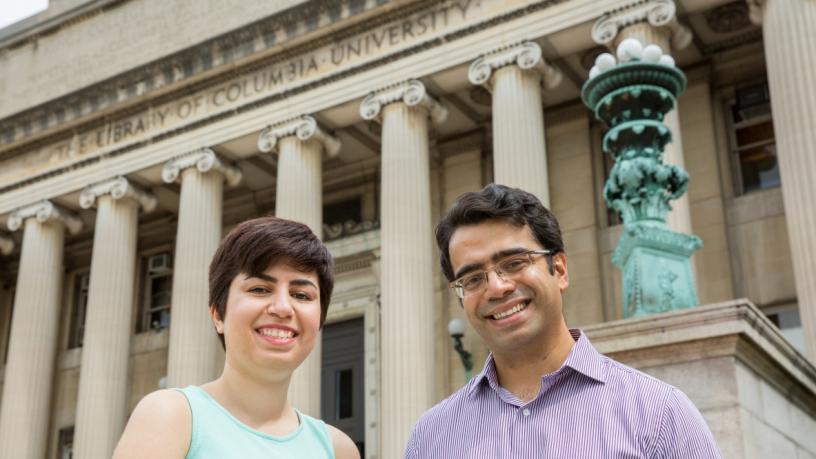Negar Reiskarimian Earns Marconi Society Young Scholar Award
Doing the impossible? That’s par for the course for Negar Reiskarimian, a PhD candidate at Columbia Engineering.

PhD candidate Negar Reiskarimian with her advisor Harish Krishnaswamy, associate professor of electrical engineering. Rieiskarimian has won the Marconi Young Scholar Award for her work developing integrated circuits for "full-duplex" wireless.
—Photo credit: Timothy Lee Photographers
With advisor Harish Krishnaswamy, associate professor of electrical engineering, Reiskarimian has developed novel integrated circuits for “full-duplex” wireless. These circuits allow transmitters and receivers to function at the same time on the same frequency—a feat that for decades scientists simply didn’t think was possible.
This achievement promises to double wireless capacity, and has already attracted nearly $4.5M of research funding from the National Science Foundation, the Defense Advanced Research Projects Agency (DARPA), Qualcomm and Texas Instruments. Now, Reiskarimian has received word that her work has also earned her a prestigious Paul Baran Young Scholar Award from the Marconi Society.
“A lot of research efforts are focused on trying to squeeze a little bit more performance out of existing chip designs,” Reiskarimian said. “What I wanted to do is find completely new applications for the circuits and tools at my disposal.”
In early 2015 Reiskarimian made an important breakthrough; investigating potential applications for N-path filters, a type of switched-capacitator circuit, she discovered a new functionality in their structure allowing for a transmitter and receiver to operate simultaneously on a shared antenna. With DARPA funding, she built a prototype chip and published a paper on her research in Nature Communications. The next year, researchers developed a full-duplex receiver based on her work, which Krishnaswamy called “the highest-impact research that I have had the privilege of participating in throughout my career.”
“What Negar has discovered represents a fundamental advance in the physics of wave propagation,” Krishnaswamy said, “and also has a big impact on practical applications.”
A native of Iran, Reiskarimian studied telecommunications and microelectronic circuits at Sharif University of Technology and came to SEAS in 2013 to research analog/RF integrated circuits and systems as a graduate student in Krishnaswamy’s CoSMIC (Columbia high-Speed and Mm-wave IC) lab. She is a member of the interdisciplinary FlexICoN (Full-duplex Wireless: From Integrated Circuits to Networks) project and a recipient of the 2016 Qualcomm Innovation Fellowship. She expects to receive her PhD this spring and plans to continue her research in academia.
Reiskarimian will receive the Young Scholar Award, which includes a $4000 prize, at a dinner in October alongside three other winners nominated by their academic advisors and selected by an international panel of leading engineers.”
“I am humbled and honored to be chosen for the Paul Baran Young Scholar Award,” she said. “That my work in circuits translates to broader audiences in the communications arena makes me very proud, and gives me assurance that I’m moving in the right direction.”
